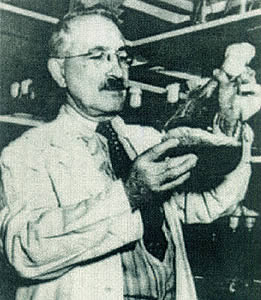Tuberculosis and Lung Disease after the Middle of the 20th Century
Anti-Tuberculosis Drugs Make the Sanatorium Obsolete, But the American Lung Association Still Fights Lung Diseases with Research and Public Education

Dr. Selman A. Waksman (1888-1973)
With the support of the American Lung Association (ALA) and its international associates, scientists made considerable progress in tuberculosis research. By the 1930s, the BCG vaccine was being used in many parts of the world. Dr. Selman Abraham Waksman, a Rutgers University microbiology professor, isolated streptomycin in 1943 and proved its effectiveness against TB. He won the Nobel Prize in 1952. Other notable anti-tubercular drugs first used in the 1940s and 50s were isoniazid and para-aminosalicylic acid. The new treatments made the TB sanatorium obsolete: in 1954, Edward Livingston Trudeau’s “Little Red Cottage” at Saranac Lake closed.

Despite the advances made since 1900, tuberculosis is still with us, along with other lung diseases that are equally devastating. Lung disease is the third leading cause of death in America. In Virginia alone, more than 600,000 people suffer from some form of lung disease.

Fortunately, of the leading causes of death in America, lung disease is the most preventable. The ALA sponsors public education programs to prevent people from beginning to smoke and to encourage smokers to quit. It campaigns against all forms of air pollution, both outdoors and in the workplace. In addition, the American Lung Association supports research and public education in lung cancer; emphysema; chronic bronchitis; asthma; respiratory distress syndrome (RDS) in both children and adults; Sudden Infant Death Syndrome (SIDS); chronic respiratory diseases like sinusitis and hay fever; and infectious diseases such as influenza and pneumonia. The ALA’s public health education and biomedical research programs are supported by donations to Christmas Seals and by other voluntary contributions.
Additional Links of Interest